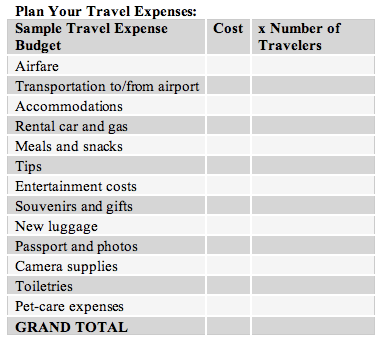Whether your vacation is in a few months or a few weeks—now is the time to start thinking about your vacation budget. You will enjoy your vacation more if you know you aren’t going into debt while taking in the sun, surf, and fun. With a little advanced planning, you can make the most of your time and money.
As you start to plan your vacation, consider these three things:
1. Where do you want to go?
2. How do you want to get there?
3. How much do you want to spend?
Taking the family on a two-week trip to a foreign country will be costly—and needs more advanced planning—than a week at the national park.
Decide in advance how you’ll pay for the trip. Saving in advance is a good way to go. Start early and decide on a certain amount you will put away each month. If you prefer to charge your vacation, make a commitment that you will pay off the bills within 90 days. This will keep you from splurging and taking a trip to Tahiti when your budget only allows for a long weekend in a local beach town. Some credit cards offer insurance on rental cars or other travel rewards. Take advantage of these perks, but remember to treat the credit card as a part of your overall vacation budget and pay it off quickly.
Once you’ve picked your travel destination, it is time to consider how you will get there. Gas prices are high again this summer, so if you considering a family road trip, here are a few ways to help you save at the pump.
• Make sure your vehicle is well maintained. A car in good working order will get better gas mileage.
• Check your tire pressure, it can affect fuel consumption. Tires should be inflated the maximum limit and checked frequently.
• Cruise control may be a fuel-saving option when you drive on open roads. Maintaining a steady speed conserves fuel.
• Use the air conditioner only when needed. Air conditioning dramatically reduces fuel economy.
If you are thinking about flying, comparison shop the Web for better deals on airline tickets. Be sure to visit multiple sites for price quotes. Agents typically charge a per-ticket booking fee. If you can bundle up services and buy more than one ticket, ask to have the booking fee waived. Be flexible with travel dates and times. By changing your travel dates even a day or two, you can save hundreds of dollars. For additional savings, try visiting destinations in their off-season: Europe in the winter; the Caribbean in September and October; Hawaii in May or September.
Once destination and travel are arranged, it is time to budget for where you will stay, how you will get around, and what activities you’ll want to do. Don’t forget to include meals and souvenirs too.
Here are few tricks to help keep expenses in check.
• Budget for the day’s adventure. It cuts down on spontaneous purchases and guards against putting too much on your credit card.
• Travel with a cooler so you’re not purchasing drinks and snacks at every rest stop.
• Tourist spots sell everything from film to sunscreen, but at a higher cost. Purchase these items before you leave and save.
As you near your vacation date, plan an itinerary and follow it. Roaming around a city without a plan can quickly turn into an expensive sightseeing trip. You can help your kids understand the importance of budgeting by giving them a vacation spending allowance. This will give them a chance to understand the importance of budgeting. They’ll know how much they can spend on treats and souvenirs.
With some advanced planning you can return from your vacation well rested and ready to save for your next trip!

Other travel tips
Before you travel, be sure to include regulations and potential emergencies in your planning. Here are some important ones to think about:
• New passport: www.passportsandvisas.com
• Required immunizations for foreign travel: www.thetraveldoctor.com
• Stringent airport security regulations: http://tsa-7.custhelp.com
• Optional trip insurance that covers trip cancellations or delays, or some medical emergencies: http://www.travelsense.org/tips/insurance.asp
Resource links
• Tripadvisor includes actual travelers’ reviews of destinations, hotels, and restaurants. www.tripadvisor.com
• Citysearch provides guides to U.S. and international cities, from shopping to restaurants to clubs. www.citysearch.com
FORGOTTEN VACATION COSTS:
Watch out for the forgotten cost when planning your vacation budget. Don’t forget that Fluffy and Fido will need to be taken care of while you are gone. Pet daycare centers average $35 per day for a single pet. You can save some money by asking family or neighbors to take care of your pets while you are away.
Tourist destinations are famous for temping vacationers with all kinds of must-have items to take home. A trip to Disneyland can easily add up to $50 per person in souvenirs. Consider whether the souvenir will just sit in the back of the closet lat home before buying.
Eating out and buying snacks between meals can add up quickly, especially at pricey tourist destinations where a $1 coke now cost $3. Travel with a cooler and pack a lunch so you don’t eat out for every meal.
Some vacation might require a new swimsuit or special equipment. Don’t forget to budget for these costs. Don’t go overboard in spending on new clothes for a trip that you won’t use when you return home. If chances are you won’t be continuing your surf lessons on the Great Salt Lake, rent a surf board instead of buying one.
Items in hotel snack fridges are notoriously overpriced. If you find yourself in need of a snack, find a nearby vending machine instead.
By Lori Chillingworth
Zion’s Bank Women’s Financial Group














Add comment